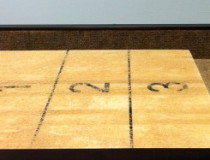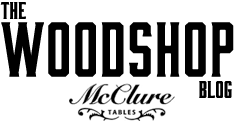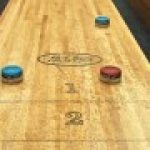
Scoring Shuffleboard is as Easy as One, Two, Three!
Scoring shuffleboard is a straightforward process in which each of the player’s shuffleboard weights are assigned a specific value based on the position on the board. It is also based on the position of the opponent’s weights at the end of each round relative to the other player’s discs.
Scoring is similar to that of curling, only with the end of the playing area being the highest value versus that of curling which uses more of a bull’s eye approach to scoring.
The scoring area is at each end of the playing surface, and made up of three zones.

The zone closest to the point from which the weights are shuffled is worth one point, the next furthest zone is worth two points, and the furthest zone away from the players is worth three points. If a puck travels to the end of the playing surface and hangs over the edge, the scoring value is four points.
Once all the shuffleboard pucks have been played the points are tabulated based on which player’s pucks are closest to the far end without going beyond the scoring area. The only points awarded are based on the furthest puck of an individual player and any subsequent puck shuffled by the same player that go beyond all the other pucks played by the opponent. Therefore, only one player is able to score points on any particular round.
As an example if Player “A” has two of their four weights that have landed in the three point zone and two in the one point zone. Player “B” has three pucks in the two point zone that are not as close to the end as the first player’s and one in the one point zone Player “A” receives six points for the round and Player “B” receives zero.
Determining which player’s puck went further is based on drawing an imaginary line perpendicular to the playing surface and agreeing on which puck is indeed closer to the end. In the unlikely event of a tie neither puck is counted toward the point value.
The winner of the game is the first one to reach either fifteen or twenty one points. This is determined prior to the beginning of play. Some games can be handicapped using a different scoring shuffleboard system in which a lower skilled player is given an additional point for each zone and hanger beginning after the foul line.
This makes the game more fun for the novice player and more competitive for the more proficient player.



We also score if the puck is not completely over the line between zones you only get the zone points before the line. example puck lands halfway between 2 and 3 the points scored would be 2.
Very good information! I am new to this board game……
Basic Question — how do you use an abacus to score on a Brunswick Andover 12 foot table? The scoring abacus (2) that came with the board has 9 silver beads and 2 colored beads (red on one, black on other). How do you use the beads to score a 15 or 21 point game?
That is hard to say but typical of a large corporation that contract manufactures in China. I would guess maybe one of the silver beads you can designate as a 10? Not sure either the marketing department, engineering or the contract manufacture in China don’t even knew how the game is played. It is just something to make and another product line to add to a large fortune 500 company. I would throw them away and buy a set of our shuffleboard table score beads here. This is why we try to write comparison articles warning the consumer about the various brands and marketing gimmicks on Shuffleboard tables and also why we have decided to offer a new Wholesale Shuffleboard Table section on our web site. You can get an American Made Liberty for less than you paid this dealer for your Andover. See our article here on Brunswick Shuffleboard Table Reviews
What is the rule of one team removes the pucks before all right puchs are shot from the other end
It is up to the tournament director in your home you can make up your own house rules, Pucks that do not clear the foul line either short or long are removed. But otherwise, pucks should stay on board until the end of the game.
Can you go over 21 to win ? Or does it have to be exactly 21
Can go over no problem
If there is a tie I understand they negate each other. Would the next closest puck get a point?
You only count the puck the furthest towards the end of the board. You can use a T square to see if you actually have a tie but if one red puck is just a fraction in front of the blue puck then only the Red scores.
Interesting, I always thought all points were totaled, and the difference in those points were given to the higher team. For example, Team A has one puck in 2 and one in 3 (5 points), and Team B has two pucks in 3 (6 points) then Team B gets 1 point (6-5) for that round.
Only the pucks in the front count. If the Time A puck in zone 2 clearly scores but the one in the 3 zone would only count if it is in front of the team B pucks in zone 3. The pucks on team B do not count at all because team A has one puck the 2 zones in front.
What part of the puck is counted for figuring out if it is over a line or not? Is it the counted by the rounded bottom where it contacts the table, or the leading edge?
Points only count if they are not touching the line, If for instance I am in the 3 zone but any part of my puck is on the line it counts as 2 points not 3
What does it mean if the puck hangs between 1/2 or 2/3?
If each team has a hanger, which one wins? Or do they cancel out?
You would have to measure which hanger actually is further in front of the other one. You can use a T square when on the surface of the board but hangers you would have to try to visually inspect.